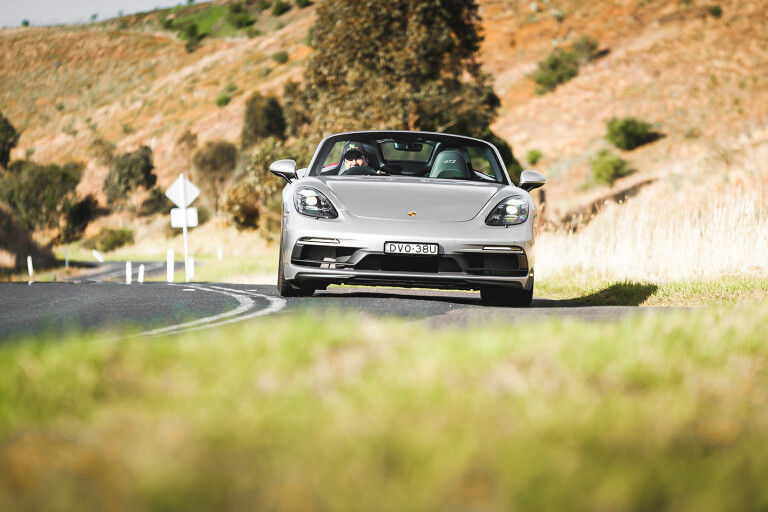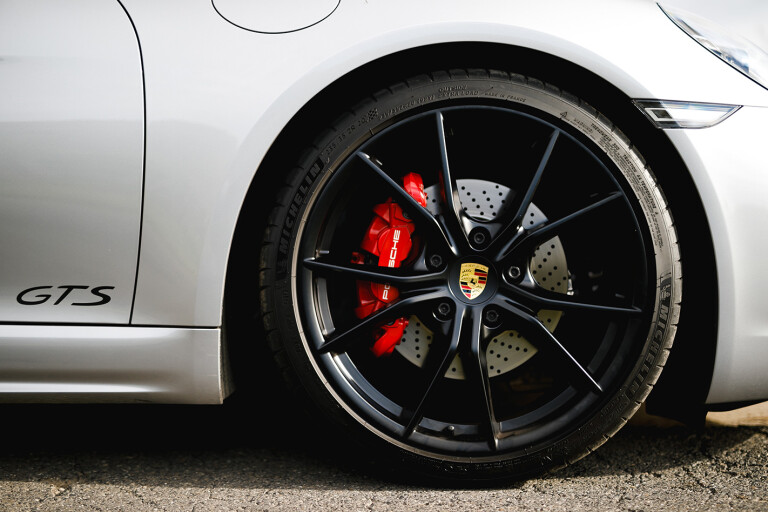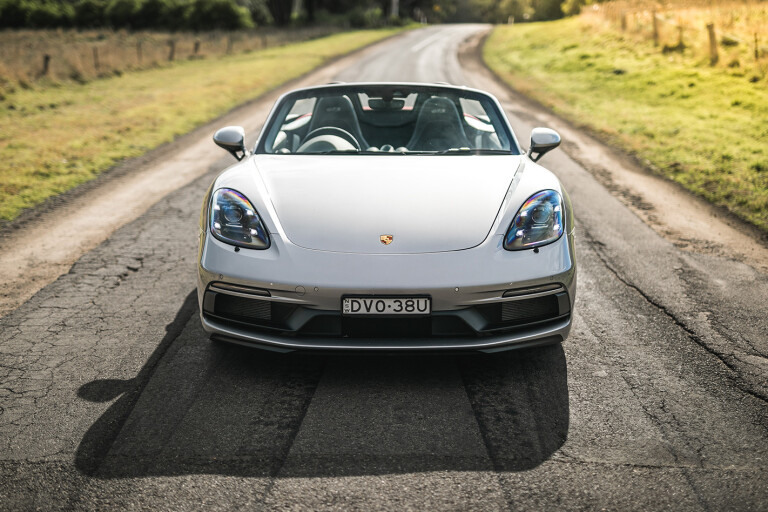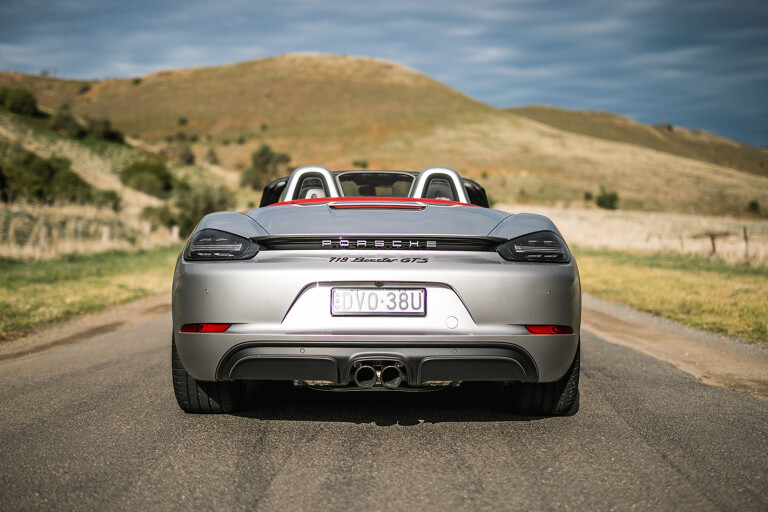
WHAT IS IT?
The brawniest Porsche Boxster to date (in terms of accessible torque at the least) is now more powerful than the original 911 GT3. Let that one sink in for a moment. Traditionally Porsche’s entry-level sportster, the Boxster has morphed into something rather serious, as indeed it needs to be while wearing the conspicuous price tag of this GTS.

WHY WE'RE TESTING IT
Having driven the standard and S versions of the 718 Boxster before, we were curious to see whether turning up the wick on Zuffenhausen’s mid-engined roadster could overcome our reservations that it’s now powered by four rather than six cylinders. The 269kW GTS model is certainly rapid but we wanted to see whether it was rewarding, too.
MAIN RIVALS
Audi TT RS Roadster, BMW M4 Competition Convertible, Jaguar F-Type V6 280 Convertible, Mercedes-AMG SLC43
THE WHEELS VERDICT
The Porsche 718 Boxster GTS is an astonishingly complete car and the best sports car in its sector by an almost embarrassing margin. There remains a certain transactional nature to its fundamental proposition: more speed in exchange for a little less delicacy, but that’s a bargain that many will be prepared to make. Given the price of Porsche options, the extra $27K over the Boxster S almost represents a bargain, in a self-consciously first-world regard. Let’s not get hung up on the minutiae though. The 718 Boxster GTS is endearingly excessive. Less is more? Not even close.

PLUS: Pace; grip; drama; interior finish; breadth of damping options; sleek styling; engineering cohesion
MINUS: Eye-watering options prices; some iffy ergonomics; poor interior storage; tuneless engine
THE WHEELS REVIEW
PETER Robinson is an effusive man. He’s great company and fiercely passionate, but seemed merely whelmed when he first road-tested the Porsche 911 GT3 for Wheels back in September 1999. Yes, he mentioned its “sledgehammer charge from 3500rpm” and describes its performance as “blistering” but signs off his test of Porsche’s soon-to-be icon with the faint praise that it remains sufficiently civilised to drive every day. Over the page he then drives Porsche’s all-new Boxster S, of which he seems a good deal more enthusiastic. Some 19 years on, we now have the 718 Boxster GTS, a car that eclipses the pace, power and poise of the 996 GT3. It’s something very special and yet it too is a car that some can’t seem to get excited about.
Here’s why. A couple of years ago, in response to ever-tightening emissions regulations, Porsche made the decision to no longer fit large capacity six-cylinder engines to the Boxster and instead use smaller turbocharged four-cylinder units. The cars were quicker and more economical than before, but many reviewers – myself included – felt that some of the magic had gone, that an element of what made Porsche so special was traded for something a little more commoditised. The GTS is Zuffenhausen making its rebuttal.

In order to throw the Boxster GTS’ talents into some sort of perspective, we had the opportunity to jump from a 911 Carrera T into the Boxster, effectively stepping from the least powerful 911 into the heaviest-hitting Boxster. Despite the Boxster finding itself at a 20Nm torque deficit on paper (430Nm vs 450Nm), the mid-engined car feels subjectively more muscular and the stopwatch doesn’t lie either. The GTS is more than half a second quicker than the purist’s 911 from 80 to 120km/h in fifth gear. Ultimately it’s a tenth slower to 160km/h and single kilometre per hour slower at the top end (290 vs 291km/h) but that gutsy feeling to the powerplant leaves a lasting impression.

It’s still not possessed of any goosebump-inducing operatics, but the exhaust makes significant amends with a cacophony of crackles on the overrun such that it’s hard to get bored of part-throttling it in Sport mode and treating passers-by to a pretty good impression of the opening bars of the Tet Offensive. The stats suggest that peak torque is available from 1900rpm, but you’ll need at least 2200rpm on the clock before the GTS picks up its skirts. From there, there’s a muted hissing and whooshing as the pace builds. By 6000rpm, the timbre has hardened but fails to build to any great crescendo. Its best work is done and from there to cutout there’s little in the way of aural payoff. That’s disappointing but the easy accessibility of this broad and deep pool of turbocharged torque makes the GTS a rangy and deceptively rapid cross-country weapon.
The GTS rides on the lowered PASM adaptive suspension as standard, which give sit a more pugnacious stance via a 10mm drop in ride height. A 20mm option is available, but without a lifter kit this will compromise the car’s day-to-day utility. There are three key drive modes to concern yourself with: Normal, Sport and Sport Plus. There’s also an Individual mode which is rendered largely unnecessary by the smart calibration of the three main settings. Normal is fine for freeway schlepping and general ambling, keeping the exhaust quiet, the damping soft and the shift points extremely mild. On occasion it can let the revs dip too low, which induces a subsonic booming to the fuselage, but a quick tap of the pedal can drop the PDK box through four gears almost instantaneously. Ride quality is mystifyingly composed for something running on 20-inch, 35 series Michelin Pilot Sport 4s.

Switch to Sport and the exhaust becomes noisier and the gear selection more aggressive, but doesn’t compromise ride quality, making it the preferred setting for Aussie back roads. Sport Plus elevates everything but the stability control to its sharpest setting. Outright grip is rarely an issue at road-legal speeds, but up the wick where permitted and you’ll feel the combination of torque vectoring and a mechanical limited slip differential giving the outside rear tyre of the Boxster everything it can post-apex. A little of the delicacy and limit-accessibility of a narrower-tyred Boxster has been lost in the quest for outright pace, but Porsche is merely answering a customer demand. It’s hard to argue with progress.
The engine changes over the S do actually comprise something other than unchecking a few lines of crippleware coding. The inlet ducts are redesigned specifically for the GTS and its freer breathing is reflected in changes to the variable-geometry turbocharger, lifting peak boost from 1.1 to 1.3 bar. This in turn massages peak power, up by 11kW. Torque is another issue. If you choose the PDK model such as our test car, for which Porsche will liberate you of another $5980, peak torque is rated at 430Nm, while the six-speed manual only hawks up 420Nm. It also tacks a few tenths to the sprint to 100km/h, the manual car registering 4.6 versus the robot’s 4.3-second time. The PDK-equipped car also has the legs to outsprint the previous Boxster benchmark, the vanishingly rare 276kW/420Nm Boxster Spyder, which shared its engine with the ballistic Cayman GT4.

Your mileage will vary on which of the two transmissions is preferable. The PDK ‘box is objectively better but there will be some who prefer the tactility of the manual shift. Just know that you’ll have to be pretty damn spry at shifting to beat a base PDK-equipped 718 Boxster that retails for about $58K less. But despite its newfound potency, the Boxster has never really been a ten-tenths sort of car. The capability is there in reserve, but those who really want to push the envelope will be naturally drawn to its sister vehicle, the Cayman. There’s not a great deal of dynamic compromise in choosing the soft-topped car, the Boxster featuring an extremely stiff superstructure and no appreciable weight penalty.

Acoustics aside, there’s little of great import to criticise. Option the electric adaptive sports seats and you’ll find your fundament a few centimetres further from the floorpan than is ideal. Taller drivers will find that the seat will recline a decent way, but this only forces an old-school Italianate driving position, which isn’t ideal. The cabin is slightly fussy in its detailing with little substantial stowage space, and it’s hard to escape the feeling that the fascia’s design trope has run its course, with Porsche set to introduce more radical dash architectures in future. The button-heavy centre stack is a welcome holdout for those who hate minor functions being delegated to a touchscreen, but the downside is seeing five conspicuous and contiguous switch blanks on a well-optioned press car that carries a price-as-tested of $209,300. Details like the basic cruise control, neurotic and seemingly random parking sensor activation and passenger seat belt clips that rattle and worry against the hard-shelled seat also jar slightly at this price point.
The go, stop and steer of the 718 Boxster GTS remains astonishingly polished. That the car once sneeringly derided as the poor man’s Porsche can show a clean pair of heels to an original GT3 in some ways signifies a coming of age, a rare embrace of function in a market sector still obsessed with form. It represents pragmatic progress through engineering by a company that has occasionally been guilty of letting its past overdirect its future. Robbo would probably appreciate that. We do.

SPECS
Model: Porsche 718 Boxster GTS PDK
Engine: 2497cc, flat 4, dohc, 16v, turbo
Max Power: 269kW @ 6500rpm
Max Torque: 430Nm @ 1900-5000rpm
Transmission: 7-speed dual clutch auto
Weight: 1450kg (EU)
0-100km/h: 4.3 sec (claimed)
Fuel economy: 8.2L/100km (EU combined)
Price: $181,880
On sale: Now



COMMENTS